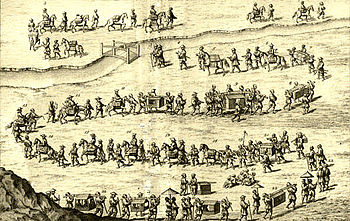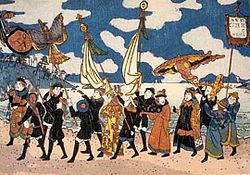- Dutch missions to Edo
-
 The Dutch procession to the Shogun's court. A XVII century European engraving depicting a Dutch tributary embassy to the Tokugawa's castle.
The Dutch procession to the Shogun's court. A XVII century European engraving depicting a Dutch tributary embassy to the Tokugawa's castle.
The Dutch East India Company missions to Edo were regular tribute missions to the court of the Tokugawa Shogun in Edo (modern Tokyo) to reassure the ties between the Bakufu and the Opperhoofd. The Opperhoofd of the Dutch factory in Dejima and his attendants were escorted by the Japanese to Edo where they presented exotic and elaborate gifts to the Shogun:clocks, telescopes, medicines, artillery and rare animals were usual gifts of the tribute missions.[1] The Shogun would correspond at the same time with gifts to the Dutch. The tribute system as in China, served to enhance the idea of the Shogun's supremacy to his subjects. [2]
 A XIX century Japanese Ukiyo-e depicting a Dutch embassy. Due to their proximity to Edo, the Dutch were required to make more visits to the capital than a more distant vassal like Ryukyu.
A XIX century Japanese Ukiyo-e depicting a Dutch embassy. Due to their proximity to Edo, the Dutch were required to make more visits to the capital than a more distant vassal like Ryukyu.
References
- ^ Dutch-Japanese relations
- ^ * Auslin, Michael R. (2006). Negotiating with imperialism: the unequal treaties and the culture of Japanese Diplomacy. Harvard University Press
See also
- Japan–Netherlands relations
- VOC Opperhoofden in Japan
- Tributary state
 Foreign relations of Japan
Foreign relations of JapanAfrica 
Asia Afghanistan · Bangladesh · Cambodia · China (PRC) · India · Indonesia · Iran · Israel · Korea (North) · Korea (South) · Malaysia · Mongolia · Nepal · Pakistan · Philippines · Saudi Arabia · Syria · Republic of China (Taiwan) · Thailand · VietnamEurope Armenia · Austria · Bulgaria · Denmark · European Union · Finland · France · Georgia · Germany · Greece · Iceland · Ireland · Italy · Kosovo · Lithuania · Netherlands · Montenegro · Russia · Serbia · Switzerland · Turkey · Ukraine · United KingdomAmericas Oceania Australia · TongaMultilateral Previous Russian Empire · Soviet UnionHistorical Missions to Imperial China · Red seal ships · Nanban trade · Sakoku · Joseon missions to Japan · Japanese missions to Joseon · Dutch missions to Edo · Ryukyuan missions to Edo · Foreign relations of Meiji Japan · Greater East Asia Co-Prosperity SphereDisputes Related topics Japanese Ministry of Foreign Affairs
Wikimedia Foundation. 2010.
